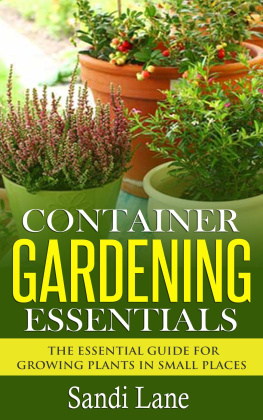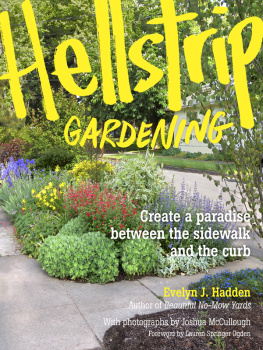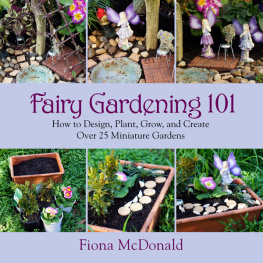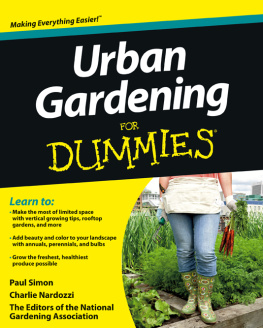
Hellstrip
GARDENING
Create a paradise between the sidewalk and the curb
Evelyn J. Hadden
With photographs by Joshua McCullough
Foreword by Lauren Springer Ogden
Frontispiece: Nothing enlivens a cementscape more than a boldly blooming garden.
Copyright 2014 by Evelyn J. Hadden. All rights reserved.
Published in 2014 by Timber Press, Inc.
Photo and location credits appear on .
The Haseltine Building
133 S.W. Second Avenue, Suite 450
Portland, Oregon 97204-3527
timberpress.com
6a Lonsdale Road
London NW6 6RD
timberpress.co.uk
Book design by Breanna Goodrow
Library of Congress Cataloging-in-Publication Data
Hadden, Evelyn J.
Hellstrip gardening : create a paradise between the sidewalk and the curb / Evelyn J. Hadden ; with photographs by Joshua McCullough ; foreword by Lauren Springer Ogden. -- 1st ed.
p. cm.
Includes bibliographical references and index.
ISBN 978-1-60469-610-3
1. Urban gardening--United States. 2. Curbs--United States. I. Title.
SB453.H18 2014
635.091732--dc23
2013040747
For curbside gardeners, who spend their time, energy, and resources bringing natures beauty and amenities out to the street where we all can appreciate them.
And for my intrepid companion, George.
Contents
Foreword
by Lauren Springer Ogden
All garden spaces are not created equal; in fact, some are overlooked as candidates for any gardening at all. This unique book embraces these forlorn spots, giving the reader compelling reasons as well as the tools needed not only to dig in but also to enjoy success creating and stewarding the newly transformed areas.
Just as homeowners and even seasoned gardeners are often intimidated by the idea of annexing such areas, authors have not had the courage, conviction, and optimism to forge ahead and write about this topic. Such writing is long overdue. Evelyn Haddens intelligence shines throughout this gem of a book. She offers a rare combination of sensitive and thoughtful treatment of the big picture and dogged, thorough coverage of things practical. This makes her thesisthat such small, seemingly meaningless places can change a home, a neighborhood, a communityutterly believable. Her wise and encouraging words give the reader pause and motivate the skeptic among us to consider picking up the shovel.
Hadden then takes the reader by the hand and shows how to do it. No stone is left unturned: we are led head-on through the joys and potential pitfalls. Practical advice on horticultural topics such as soil, water, and plants abounds. This is joined by evenhanded, generous advice on the more unusual situations that these gardens often engender, such as covenants and regulations and how to negotiate them with more positive outcomes. She graciously exhorts the reader to share plants with neighbors, to open curbside gardens to passersby, and to gently push for change in existing ideals and practices that stifle gardens, promoting community rather than rebellion. I wish I had read her advice twenty-five years ago before embarking on my conflict-fraught first hellstrips, where as a zealous young upstart I spent as much time (or more) butting heads with neighbors and town authorities as I did tending and enjoying the new gardens.
As Hadden makes a case for these gardens and teaches us to succeed with them, she is welcoming and positive, yet always matter-of-fact, practical, fair, and not preachy. Give that leftover a makeover, she cheers, and then gives the reader the dirt on how to do it, literally and figuratively. Her honesty is refreshing, especially in light of the prevalent misguided claim that lawn alternatives are lower maintenance. Of course a fabulous curbside garden will require more tending than an abandoned plot or even a poorly tended strip of lawn. This book faces down these challenges and doesnt mislead. And whats more, the information and advice given here transcends these difficult spots and can be applied to gardens of all sorts.
Open the pages that follow and begin a journey that can make a difference to you and your neighborhood, that impacts people, plants, animalsthe web of life around you. Take part in creating corridors of diversity by adding environmentally intelligent garden snippets to serve as lively sanctuaries in this ever more crowded and unnatural world. With the help of this fine book, stretch your gardening wings and garden space, create curb appeal for bees, birds, butterflies, and passersby alike, and watch dogs stop, sniff, and then continue on down the road to find some lawn or bare patch to do their business. After reading this book, you may wish for more unloved, forlorn spots on which to work some garden magic.
Introduction
Why Curbside Landscapes Matter
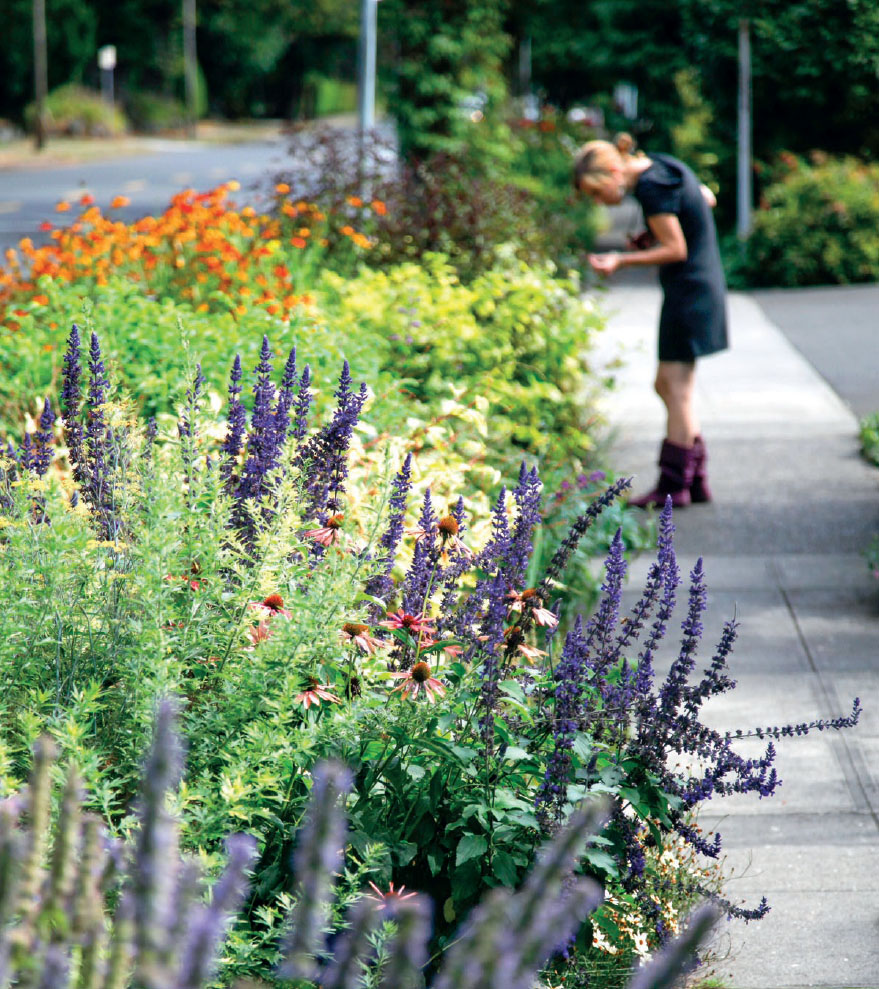
Curbside gardens are an essential ingredient of pleasant, walkable neighborhoods.
Many of us own or manage pieces of land that are part of the public landscape, a landscape that other people interact with every day. That public environment uplifts our mood or sends it plummeting, rivets us in the present moment or fails to distract us from our busyness. Attractive scenes invite us to open our senses and our hearts, while ugly or barren surroundings train us to block those sensory messages.
Yes, curbside landscapes have that much power. And by extension, we who own and manage those landscapes also have power.
I invite you to use your power, to make your own contribution to the public landscape. Convert a sparse, weed-ridden curbside lawn to smile-inducing scenery that doesnt need much help to stay healthy. Outside the fence, down the steps, or beside the driveway, incorporate ignored and deplored bits of land into the rest of your garden, or help them shine as stand-alone pocket gardens that brighten the routes of commuters.
Youll add curb appeal, and youll also improve the daily life of your neighborhood and its denizens. The gifts of a curbside garden are disproportionately large. Natural scenes, even minutely glimpsed in passing, distract us from worry and interrupt negative psychological cycles. Garden fragments purify and freshen air, absorb and filter water, and foster biodiversity with its associated services and benefits, not to mention lowering crime and raising property values.
With just one garden, you can make living where you liveand visiting toomore fragrant, more lively, more peaceful, more interesting, more earth-friendly, and more appealing.
What Are Curbside Gardens?
Curbside locations are the public faces of places. Though they are the last areas we may think to beautify, they provide the first glimpses of what to expect inside a building, through a gate, or across a threshold. They may be the places most used by wildlife passing through our properties, and the places where runoff, litter, and human visitors are apt to loiter. These tough environments dont often support healthy lawns, but they can host thriving gardens that dramatically improve their surroundings.
Parking strips (the piece of land between a street and a public sidewalk, also known as a tree park, boulevard, verge, hellstrip, meridian, planting strip, or inferno strip) make promising spots for curbside gardens. So do front yards that are simply one outdoor room from curbside to front door. Although the most challenging area of such a front yard may be located alongside the street, driveway, or public walk, the gardener will likely want to design the entire room as a whole, not just one edge of it.
Next page




